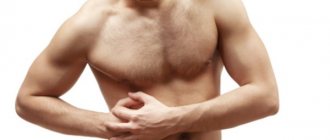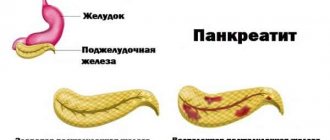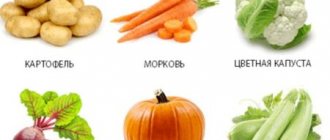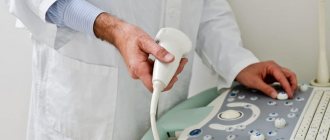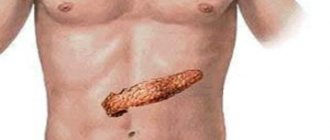Characteristic signs of inflammation of the pancreas
The pancreas is one of the most important organs. It is assigned the following functions:
- Maintaining glucose balance;
- Regulation of the digestive process;
- Enzyme production;
- Normalization of metabolic processes, etc.
In most cases, the patient has been harming the pancreas for years, which does not show symptoms for the time being. At some point, it is possible to diagnose a chronic form of inflammation. It is more dangerous to find out about the presence of pancreatitis during an acute attack, when there is a possibility of death.
Signs of an inflammatory process in the pancreas:
- Burning in the pancreas and heaviness.
- Pain of varying intensity and duration, usually radiating to the left side.
- Dyspeptic disorders: diarrhea, vomiting, hiccups, shortness of breath.
- Decreased appetite and weight loss.
Causes of heartburn with pancreatitis
The inflammatory process in the pancreas has the main symptom - heartburn, which appears for the following reasons:
- The breakdown of fats, proteins and complex carbohydrates is carried out in the “pancreas” with the help of enzymes. The food consumed, moving through the digestive system, is susceptible to the action of digestive enzymes and is successfully broken down. However, if there is a failure in the digestive system, the contents of the stomach continue to flow, but in a state that is not ready for absorption. As a result, a person experiences symptoms such as pain, nausea, heartburn, as well as vomiting and stool disorders. Over time, the unprocessed contents of the stomach stagnate and sour, which ultimately leads to inflammation of the esophagus and stomach.
- Disorders of the digestive tract along with inflammation of the pancreas can cause a burning sensation in the esophagus. For example, inflammation of the mucous layer of the esophagus together with chronic pancreatitis or a stomach ulcer.
- Burning pain behind the sternum occurs with pancreatitis due to sudden changes in a person’s life or diet. The pancreas is sensitive to such changes and therefore reacts painfully to them.
Return to contents
Burning sensation in the pancreas as a symptom of pancreatitis
Pain syndrome is the body’s clearest signal about organ dysfunction. Its intensity depends on the degree of damage to the pancreas. Based on the localization of pain, it is already possible to guess which part of the organ (head, body or tail) is affected.
The nature of the pain can vary from aching, pulling, sharp to burning. A burning sensation coupled with pain indicates chronic pancreatic disease, which is accompanied by increasing atrophy in the parenchyma of the organ.
Burning in the epigastric area is otherwise called pancreatic colic, whose duration can be measured in hours or even days. Depending on the swelling of the pancreas, the burning sensation is more or less pronounced.
Patients often experience a pulsation against the background of a burning sensation, which indicates a spasm caused by the inflammatory process. Contractions of the vascular walls are jerky. With pancreatitis, the abdomen transmits pulsation of the aorta. However, sometimes there may be no pulsation in the abdominal aorta. This phenomenon is called the Voskresensky symptom, which indicates a severe degree of organ damage - severe swelling, collapse and pain shock.
Treatment
If the pancreas is sick, how to treat it? Treatment of diseases that cause pain should only be carried out under the supervision of a doctor. During the period of exacerbation of the disease, the patient is required to:
Article on the topic:
The norm of amylase in the blood of women depending on age
- Avoid fatty and heavy foods and alcohol consumption;
- Switch to fractional meals;
- Contact your doctor.
For the first day when pain appears, you do not need to eat anything, drink still water, which will reduce the load on the diseased organ and stop the production of enzymes. You can drink a decoction or infusion of rosehip, weak black tea. You should avoid juices and fruit drinks. You need to drink 1.5 - 2 liters of fluid per day.
On the second day, you can start eating vegetable puree, steamed fish and lean meat cutlets, and omelet. When the pain decreases, you can switch to low-fat cottage cheese, sour milk, drink compote or jelly. You will have to give up fried, fatty, spicy, smoked, salty foods, baked goods and chocolate for a long time. Fruits can be eaten baked, vegetables - boiled or steamed.
Acute pancreatitis is usually treated in a hospital. When treating chronic pancreatitis it is required:
- Eliminate pain;
- Restore the functionality of the gland;
- Take measures to prevent complications.
How to relieve pain? Painkillers are used to relieve pain: paracetamol - it will reduce swelling of the pancreas and have an analgesic effect.
If the painkiller does not take effect for a long time, you need to take the knee-elbow position to reduce the pain. The pressure of the diseased organ on the central abdominal nerve node will decrease and the pain will decrease. You can also put ice on the stomach and side to reduce the functionality of the organ.
Antispasmodics will help anesthetize the pancreas, relax the muscles of its ducts and normalize the outflow of pancreatic secretions:
- Drotaverine is a popular inexpensive vasodilator that affects smooth muscle tissue, removing spasms that cause pain. Drotaverine, by dilating blood vessels, helps to be enriched with oxygen at the cellular level.
- No-spa is recommended for a wide range of diseases: pathologies of the gastrointestinal tract, various kidney diseases, cholelithiasis, and pathologies of the bladder.
- Papaverine is injected directly into the rectum, from which it quickly spreads throughout the tissues and relieves spasms. The drug improves blood circulation and relieves pain. Drotaverine No-shpa
Papaverine
Other drugs include:
- Metocloprami d is an antiemetic that reduces nausea, hiccups and stimulates peristalsis of the upper gastrointestinal tract.
- Antibacterial Abactal, Vancomycin and Ceftriaxone will destroy bacteria and help prevent such formidable and dangerous complications as peritonitis, abscess and sepsis.
- Omeprazole is a fast pain reliever that reduces acid levels.
- Hilak Forte and Smecta will help with diarrhea .
- To prevent the development of symptoms of poisoning, you can take Enterosgel.
Metoclopramide Omeprazole Abaktal Hilak Forte Eneterosgel Enzymes
are required for pancreatitis to normalize digestion. They deliver to the body the elements necessary to normalize the processes of absorption and assimilation. The active substance found in enzymes is called pancreatin. Pancreatin-containing medications are Mezim, Festal, Creon, Pankreon, etc. The active substance is enclosed in an enteric coating to prevent its destruction in the stomach acid. In the duodenum, the alkaline environment corrodes the membrane and enzymes are released.
Mezim Festal Creon
Antacids are prescribed if the pathology is accompanied by exocrine insufficiency and dyspepsia. Antacids suppress the synthesis of hydrochloric acid by stomach cells. Phosphalugel, Maalox, Almagel reduce the acidity of the gastric environment, ensure rapid restoration of the gland, and have an enveloping effect. These drugs can also bind pathogens and remove toxic substances and gases from the body.
How to get rid of a burning sensation in the pancreas
A patient diagnosed with pancreatitis begins to experience a feeling of heaviness and burning due to disruptions in the digestive process, which is inevitable with inflammation. There is a lack of enzymes, causing a slowdown in the digestion process of the bolus. This is especially evident an hour or two after finishing a meal.
An integrated approach will help you get rid of heartburn. The attending physician, based on the individual clinical picture, will prescribe medications whose action is aimed at eliminating pain and reducing acidity levels.
They have proven themselves excellent in this matter:
The fight against burning begins after the pain syndrome has been neutralized. For this purpose take:
Burning sensation with pancreatitis in the pancreas: what is it?
A burning sensation in the pancreas area is often accompanied by pain, heartburn, throbbing, and a feeling of heaviness in the abdominal area. Why is this happening? Because the gland is an extremely important organ that regulates the glucose balance in the body; responsible for the production of enzymes; controls the process of digestion and metabolism.
At the slightest malfunction in the functioning of the organ, deviations in the functioning of the digestive tract appear, glucose levels drop, and enzymes cease to be broken down normally. This leads to the development of serious pathologies, which can quickly become neglected if their first signs are not taken into account in time.
In most cases, people with symptoms of pancreatic disease have been harming their pancreas for years. However, they did not feel much discomfort until the inflammation took on a significant form. It can cause a life-threatening acute attack, so at the first signs of inflammation of the organ, you should consult a doctor. These include:
- Burning;
- Abdominal pain spreading to the left side;
- Dyspnea;
- Nausea, vomiting;
- Diarrhea;
- Weight loss:
- Itching near the navel;
- Poor appetite.
How is a change in pancreatic function expressed?
The pancreas is an important human organ that influences the functioning of the entire gastrointestinal tract, the function of which is to produce special enzymes necessary for the correct and complete digestion of food, and has a guiding effect during metabolic processes.
Violation of the organ, as evidenced by heartburn, occurs due to many factors. Poor nutrition with the consumption of spicy, fatty foods, high blood sugar lead to problems with the functioning of the organ.
Pancreatitis is a dysfunction of the gland, it begins to become inflamed. The disease is characterized by the following symptoms:
- nausea, vomiting;
- malaise;
- burning in the chest;
- bowel dysfunction: diarrhea, flatulence;
- pain in the shoulder blades of a girdle nature.
If the pathology is advanced and has become chronic, then nearby digestive organs become inflamed - the duodenum, the gallbladder.
With good pancreatic performance, the produced enzymes enter the first section of the small intestine (duodenum). During inflammation, enzymes are unable to be directed to food that needs processing, which is why their outflow is disrupted. Then these components begin to “eat” the pancreatic organ itself, which causes digestive dysfunction. In this regard, heartburn is an integral sign of pancreatitis.
Why does the pancreas burn?
A burning sensation in the pancreas is a clear signal that the organ is not working properly. It can be weak, strong, appear within a few hours, or not go away either day or night.
In any case, you should pay attention to unpleasant sensations and immediately seek help from specialists. They will determine by the nature of the localization of the burning sensation which part of the gland is affected - the tail, head or body.
In general, a burning sensation in this organ indicates the development of pancreatitis, which has already become severe.
Tissues in the gland atrophy, and this process increases. Burning sensations in the epigastrium occur from its swelling. If the swelling is large, they will be pronounced, painful, if small, they will be weak.
The causes of burning can be different. These include:
- Disturbances in the digestive system. Typically, enzymes are responsible for the breakdown of proteins, fats, and carbohydrates in the pancreas. The food that a person eats moves through the digestive tract, under the normal functioning of the pancreas, under the influence of these enzymes it is broken down and digested well. If there are not enough of them, the food that enters the stomach is practically not digested and turns into a lump. As a result, a person experiences nausea, heartburn, and sometimes vomiting and diarrhea. Over time, the contents of the stomach become sour and cause inflammation.
- A burning sensation may appear due to acute inflammation of the pancreas, which causes disturbances in the functioning of the digestive organs. This, for example, may be the development of a stomach ulcer or inflammation of the walls of the esophagus.
- The occurrence of burning pain with pancreatitis often appears with sudden changes in a person’s diet or lifestyle. The pancreas reacts very sharply to them.
Causes of pain and symptoms of the inflammatory process
When pancreatitis occurs in the pancreas, the patient exhibits a number of symptoms that already allow one to draw a conclusion about the nature of the processes occurring in the body. Inflammation begins to manifest itself as prolonged constipation, subsequent bloating and the appearance of bad breath. Then the person is bothered by pain in the side on the right - it aches in the place where the gland is located. The pain can be so severe that a person cannot calmly move or turn, and the side reacts even to touch. In the future it may:
- The temperature rises greatly;
- Apathy and weakness begin;
- Nausea and vomiting may occur, and some may experience diarrhea;
- The pulse quickens;
- The sclera of the eyes turns yellow;
- On palpation, pronounced pain in the walls of the abdominal region is felt.
Article on the topic:
Symptoms of pancreatitis in men. How to recognize pancreatic disease
Painkillers do not help with these pains or only help for a very short time. In severe form, the disease leads to exhaustion, dehydration and decreased blood pressure.
The main reasons for pain in the pancreas may be:
- Improper unbalanced diet;
- Alcohol abuse;
- Incorrect dosage of antibiotics or hormonal agents;
- Metabolic disorders;
- Pancreatitis;
- Gastrointestinal diseases;
- Gallbladder diseases;
- Thyroid diseases;
- Injuries.
The main causes of burning in the stomach
The stomach is the part of the digestive tract where food is digested, followed by transport of the bolus of food to the intestines, where the processes of breakdown and absorption continue.
The stomach is a muscular organ, has a thick wall that can contract intensively to ensure the digestion process. The internal lining, whose cells produce pepsin and hydrochloric acid, is of great importance for the functioning of the organ.
Patients can characterize unpleasant sensations in the projection of the stomach in different ways: pain, discomfort, burning, spasms, cramps, heaviness. This depends on the person’s pain threshold, his tolerance to pain and the nature of the pathological process in the organ.
If there are certain problems with the stomach, a person may complain of a burning sensation in the epigastric region.
The causes of this symptom may be:
Inflammation of the gastric mucosa - gastritis
The etiology of the disease is different. The process can be acute or chronic. Almost every second person on our planet suffers from gastritis.
Often the disease is asymptomatic. A burning sensation in the stomach is more typical for gastritis with high acidity (
hyperacid). Excessive production of hydrochloric acid leads to inflammation of the mucous membrane.
The pain with such gastritis is similar to “ulcerative”: it occurs on an empty stomach, can be at night, passes or decreases after eating. Combined with belching sour contents, heartburn, constipation.
Duodeno-gastric reflux
The pathology is the return of bile from the duodenum to the stomach
.
Develops with stagnation of bile, cholelithiasis, and pathology of the pancreas. Bile, which has an alkaline reaction, when it enters the stomach, triggers the process of acidification of the environment - hydrochloric acid begins to be intensively produced, which, in turn, causes irritation and inflammation.
A reflection of these processes can be a burning sensation that occurs in a person.
Functional stomach disorder
It is usually associated with errors in diet. These include: overeating, excessive consumption of heavy food at night, abuse of fast food and sweets, poor food compatibility, and alcohol intake.
The physiological cause of burning in the epigastrium may also be during pregnancy. In the early stages, this symptom is explained by hormonal changes, and in the later stages it is caused by the pressure of the enlarged uterus on the internal organs.
Stress
A burning sensation in the stomach can occur during intense emotional distress. This is due to changes in the acidity of gastric juice.
In addition, under stress, hormones are released - glucocorticoids, which contribute to the formation of erosions on the gastric mucosa. Sometimes so-called “stress ulcers” even develop.
Taking medications
A burning sensation in the stomach can be a side effect of many medications. Nonsteroidal anti-inflammatory drugs prescribed for pain in the back, joints, muscles, and headaches have a pronounced ulcerogenic effect.
Smoking
It would seem that inhaling tobacco smoke only affects the respiratory organs. In fact, the negative impact also extends to the stomach. It is expressed in a violation of the secretion of gastric sleep, spasm of the stomach muscles.
There are other dangerous causes of stomach pain:
- gastrointestinal tract infections,
- diaphragmatic hernia,
- peptic ulcer,
- polyps,
- malignant neoplasms.
In order not to miss a serious disease, a doctor should evaluate the significance of such a symptom as a burning sensation in the stomach.
Dear readers, subscribe to the channel “
Your Family Doctor ” so as not to miss new publications.
Share this information with your friends on social networks and like it - I will be pleased to see that my efforts are appreciated.
Characteristic signs of inflammation of the pancreas
The pancreas is one of the most important organs. It is assigned the following functions:
- Maintaining glucose balance;
- Regulation of the digestive process;
- Enzyme production;
- Normalization of metabolic processes, etc.
In most cases, the patient has been harming the pancreas for years, which does not show symptoms for the time being. At some point, it is possible to diagnose a chronic form of inflammation. It is more dangerous to find out about the presence of pancreatitis during an acute attack, when there is a possibility of death.
Signs of an inflammatory process in the pancreas:
- Burning in the pancreas and heaviness.
- Pain of varying intensity and duration, usually radiating to the left side.
- Dyspeptic disorders: diarrhea, vomiting, hiccups, shortness of breath.
- Decreased appetite and weight loss.
How to get rid of a burning sensation in the pancreas
A patient diagnosed with pancreatitis begins to experience a feeling of heaviness and burning due to disruptions in the digestive process, which is inevitable with inflammation. There is a lack of enzymes, causing a slowdown in the digestion process of the bolus. This is especially evident an hour or two after finishing a meal.
An integrated approach will help you get rid of heartburn. The attending physician, based on the individual clinical picture, will prescribe medications whose action is aimed at eliminating pain and reducing acidity levels.
They have proven themselves excellent in this matter:
The fight against burning begins after the pain syndrome has been neutralized. For this purpose take:
A mandatory step in the treatment of heartburn and pancreatitis in general is following a diet. Excluding fried, spicy and fatty foods from the diet, as well as coffee, alcoholic and carbonated drinks is an integral principle for restoring the pancreas after an attack of inflammation.
How to help the gland with chronic pancreatitis
Chronic pancreatitis, like any other chronic disease, must be treated throughout your life. The drug treatment regimen depends on the general condition of the patient, the degree of damage and functional failure of the organ, as well as the presence of concomitant diseases and complications.
The basis of treatment is a special diet and complete abstinence from alcohol, even if organ damage is not caused by alcohol intoxication.
To help the pancreas stay in remission longer during chronic pancreatitis, it is necessary to monitor the health of the entire digestive system and try to promptly cure emerging pathologies of the liver, gall bladder and ducts. Compliance with these measures protects against frequent attacks and the development of severe consequences.
Prevention of pancreatitis
Where is the important organ of the digestive system, the pancreas, located?
The pancreas is an oblong organ located behind the stomach, approximately five to ten centimeters above the navel. The length of the pancreas is 15–22 centimeters, and its weight is only 50–70 grams. The organ consists of three sections, which doctors call the head, body and tail. The head is adjacent to the duodenum, the body is located close to the stomach, and the tail is located next to the spleen.
Although the pancreas is a relatively small organ, it has many diverse functions. The pancreas secretes pancreatic juice - a “cocktail” of enzymes and salts necessary for the breakdown of various nutrients and their absorption. Without enzymes, we would not be able to digest food. There are dozens of types of them produced in our body, not only in the pancreas, but also in the stomach, salivary glands, and intestines.
Each enzyme is designed to break down a strictly specific type of substance: some deal with proteins, others with connective tissues, others with carbohydrates, and so on. A lack of even one of them can lead to significant digestive problems.
In addition, the pancreas produces hormones necessary for metabolic processes - in particular, insulin.
Why the pancreas hurts: finding out the reasons
Pain in the pancreas never just happens. They always signal problems, more or less serious.
Pain in the pancreas often occurs with diseases such as pancreatitis, viral hepatitis, pathologies of the biliary tract, in which the outflow of bile is disrupted, diabetes, tumors, autoimmune diseases, and helminthic infestations. Pain in the pancreas is most severe with pancreatitis.
Pain often accompanies the use of certain medications, such as corticosteroids, hormonal drugs, and tetracycline antibiotics.
However, very often pain in the pancreas is caused not by disease, but by errors in diet. If we overeat or consume too much alcohol and heavy fatty foods, the gland works to its limit to help the body absorb them.
How to understand that it is the pancreas that hurts? It is not difficult to identify the problem; pain in the pancreas manifests itself quite specifically. The pain is localized in the area around the navel, and in acute pancreatitis it radiates to the back - doctors call this effect “girdling pain.” Pain in the pancreas intensifies after heavy or fatty foods, alcoholic drinks, and also when lying on your back. This pain is practically not relieved by analgesics and antispasmodics, is constant, non-attack-like and weakens slightly if you sit down and bend forward. With pancreatitis, in addition to pain, nausea and vomiting, weakness, and sweating are observed.
What to do if your pancreas hurts: recommendations
Pain in the pancreas is often so severe that a person has no choice but to consult a doctor. And this is the right decision: if you suspect a problem with the pancreas, you should under no circumstances self-medicate. As we said above, this pain accompanies many different diseases that require different therapies. And the cause can be determined only after a comprehensive diagnosis: laboratory tests, ultrasound, tomography, X-ray examination and, in some cases, diagnostic laparoscopy.
Therapy for the underlying disease always includes a set of measures.
- Diet . The first task in treating the pancreas is to relieve this organ as much as possible and facilitate its work. Regardless of what caused the pain in the pancreas, a gentle diet is prescribed. First of all, you need to completely eliminate alcohol, carbonated drinks, coffee and strong tea, spicy, fatty, fried foods, and chocolate. Even in healthy people, overuse of these products can cause discomfort in the pancreas area. Usually the so-called table No. 5 is prescribed - a menu based on restrictions on fats and acidic foods. Table No. 5 is steamed or boiled food, puddings and jellied meat, lean meat, poultry and fish, foods rich in pectin and fiber: grain bread, sweet berries, pasta, vegetables. You need to eat little and often - this allows the gastrointestinal tract to absorb food without turning on the “emergency mode”. It is advisable to eat at least five times a day, but the portions should be small. By the way, such a diet will be useful not only for those who suffer from serious diseases of the liver and pancreas. It will help you recover from excessive feasting. Even healthy people are familiar with symptoms such as heaviness in the stomach, nausea, flatulence and indigestion - the penalty for overeating or unusual food. After the holidays with their endless meals and libations, it will be useful to temporarily switch to a soft diet to return digestion to normal. Table No. 5 is a comfortable diet and does not involve giving up a wide group of foods.
- Drug therapy . Treatment depends on the underlying disease, but in any case, the doctor will prescribe medications that will help relieve symptoms and improve the functioning of the digestive tract. For pain in the pancreas, painkillers are prescribed to relieve acute attacks, antacids to restore the level of gastric acidity and normalize digestive function, as well as enzyme preparations (for chronic pancreatitis outside the period of exacerbations). The enzymes they contain are practically no different from our own enzymes and help cope with the absorption of food if the pancreas cannot produce enough pancreatic juice. In addition, in some cases, choleretic agents and antisecretory substances (so-called H2-blockers of histamine receptors and proton pump inhibitors) are prescribed.
Proper nutrition
Therapeutic diet plays an important role in the treatment of pancreatitis and heartburn resulting from inflammation of the pancreas. Proper nutrition, which will help neutralize the burning sensation in the esophagus, is based on eating fresh and natural foods. In order not to overload the pancreas, you should eat five or six times a day, but in small portions, and the last meal should be two hours before bedtime.
THIS IS REALLY IMPORTANT! Cheap product No. 1 for the stomach and esophagus. FIND OUT >>
To improve intestinal motility, you should regularly consume the following foods:
- Vegetable fats. They are introduced into the daily diet in small quantities to restore metabolism.
- Fermented milk products. The patient's menu must include cottage cheese and yogurt, but with a minimum fat content.
- Freshly squeezed vegetable juices.
- Cereals. To improve the functioning of the digestive tract, you should regularly consume fiber; it can be found in large quantities in cereals.
- Lean fish and meat.
The therapeutic diet is based on the consumption of healthy foods, so coffee, alcohol, carbonated drinks and strong tea should be excluded from the patient’s diet. Doctors recommend consuming as little sugar as possible. Eating should not be done quickly; food should be chewed thoroughly so that it is well absorbed. Buckwheat porridge eaten on an empty stomach has a beneficial effect on the digestive system. Bran bread, wheat pasta and brown rice stabilize the secretion of stomach acid.
